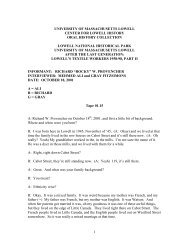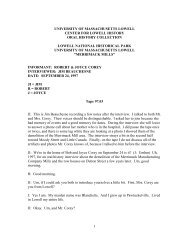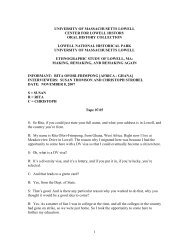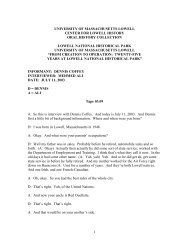LOOM AND SPINDLE OR Life Among the Early Mill Girls WITH A ...
LOOM AND SPINDLE OR Life Among the Early Mill Girls WITH A ...
LOOM AND SPINDLE OR Life Among the Early Mill Girls WITH A ...
You also want an ePaper? Increase the reach of your titles
YUMPU automatically turns print PDFs into web optimized ePapers that Google loves.
Their lives had kept pace for so many years with <strong>the</strong> stage-coach and <strong>the</strong> canal that <strong>the</strong>y<br />
thought, no doubt, if <strong>the</strong>y thought about it at all, that <strong>the</strong>y should crawl along in this way<br />
forever. But into this life <strong>the</strong>re came an element that was to open a new era in <strong>the</strong><br />
activities of <strong>the</strong> country.<br />
This was <strong>the</strong> genius of mechanical industry, which would build <strong>the</strong> cotton-factory, set in<br />
motion <strong>the</strong> loom and <strong>the</strong> spinning-frame, call toge<strong>the</strong>r an army of useful people, open<br />
wider fields of industry for men and (which was quite as important at that time) for<br />
women also. For hi<strong>the</strong>rto woman had always been a money-saving, ra<strong>the</strong>r than a moneyearning,<br />
member of <strong>the</strong> community, and her labor could command but small return. If she<br />
worked out as servant, or "help," her wages were from fifty cents to one dollar a week; if<br />
she went from house to house by <strong>the</strong> day to spin and weave, or as tailoress, she could get<br />
but seventy-five cents a week and her meals. As teacher her services were not in demand,<br />
and nearly all <strong>the</strong> arts, <strong>the</strong> professions, and even <strong>the</strong> trades and industries, were closed to<br />
her, <strong>the</strong>re being, as late as 1840, only seven vocations, outside <strong>the</strong> home, into which <strong>the</strong><br />
women of New England had entered. (Author's note: These were teaching, needlework,<br />
keeping boarders, factory labor, type-setting, folding and stitching in book binderies….)<br />
The Middlesex Canal was one of <strong>the</strong> earliest factors in New England enterprise. It began<br />
its course at Charlestown <strong>Mill</strong>-pond, and ended it at Lowell. It was completed in 1804, at<br />
<strong>the</strong> cost of $700,000, and was <strong>the</strong> first canal in <strong>the</strong> United States to transport both<br />
passengers and merchandise. Its charter was extinguished in 1859, in spite of all<br />
opposition, by a decision of <strong>the</strong> Supreme Court. And thus, in less than sixty years, this<br />
marvel of engineering skill, as it was <strong>the</strong>n considered, which was projected to last for all<br />
time, was ''switched off <strong>the</strong> track " by its successful rival, <strong>the</strong> Boston and Lowell<br />
Railroad, and, with <strong>the</strong> stage-coach and <strong>the</strong> turnpike road became a thing of <strong>the</strong> past.<br />
The course of <strong>the</strong> old Middlesex Canal can still be traced, as a cow-path or a woodland<br />
lane, and in one place, which I have always kept in remembrance, very near <strong>the</strong><br />
Somerville Station on <strong>the</strong> Western Division of <strong>the</strong> Boston and Maine Railroad, can still<br />
be seen a few decayed willows, nodding sleepily over its grass-grown channel and ridgy<br />
paths,–a reminder of those slow times when it took a long summer's clay to travel <strong>the</strong><br />
twenty-eight miles from Boston to Lowell.<br />
The Boston and Lowell Railroad, probably <strong>the</strong> first in <strong>the</strong> United States, went into<br />
operation in 1835. I saw <strong>the</strong> first train that went out of Lowell, and <strong>the</strong>re was great<br />
excitement over <strong>the</strong> event. People were ga<strong>the</strong>red along <strong>the</strong> street near <strong>the</strong> " deepot,"<br />
discussing <strong>the</strong> great wonder; and we children stayed at home from school, or ran<br />
barefooted from our play, at <strong>the</strong> first "toot " of <strong>the</strong> whistle. As I stood on <strong>the</strong> sidewalk, I<br />
remember hearing those who stood near me disputing as to <strong>the</strong> probable result of this new<br />
attempt at locomotion. " The ingine never can start all <strong>the</strong>m cars!" "She can, too." "She<br />
can't." "I don't believe a word of it." "She'll break down and kill everybody," was <strong>the</strong> cry.<br />
But <strong>the</strong> engine did start, and <strong>the</strong> train came back, and <strong>the</strong> Boston and Lowell Railroad<br />
continued an independent line of travel for about <strong>the</strong> same number of years as its early











